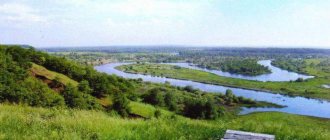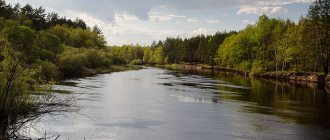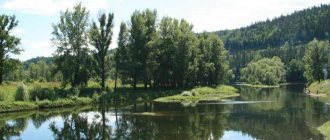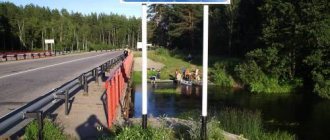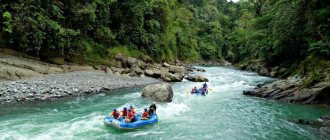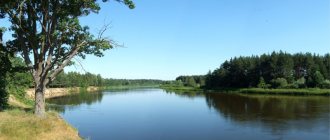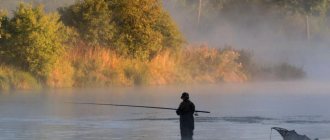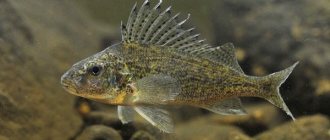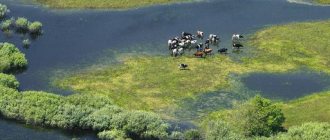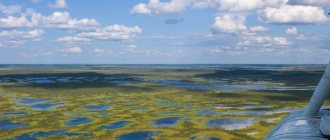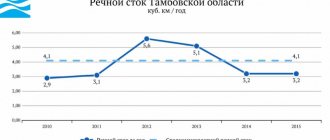Information about Izhora
The small river Izhora originates from the village of Skvoritsy, Gatchina region, at the confluence of the Sokolovka and Pudost rivers there. Its length is 76 km and it flows into the Neva River on the left side of its mouth in the village of Ust-Izhora in the Kolpinsky microdistrict of St. Petersburg.
The river is considered flat; it flows in the south and in the center of the Silurian plateau, as well as along the Neva lowland. The width of the Izhora varies from the source, where it is 2.36 meters, to the mouth, here it is 62 m. On average, its depth is 1.5-2 m, and at the mouth it is 4 m. The slope of the river is 1.2 m /km. And its total fall is 93 m.
In the upper part the river is narrow and shallow, its flow is fast up to 1.25 m/s. The high speed is due to the Silurian plateau. On average, water consumption is 11.37 m3/s.
From the source to Vyakhtelevo, the left bank is flat, and the right bank is steep, up to 9 m high, and then both banks are low.
A distinctive feature of the river is its high flow speed. Therefore, the short length of Izhora and its good speed do not allow most harmful substances to be deposited on the bottom, where the rocks are even visible, and within 16 hours they are carried to the Neva, after a day they end up in the Baltic Sea.
The water intake of the Nevsky Vodokanal, which supplies water to the residents of St. Petersburg, is located below the confluence of the Izhora and the Neva, and therefore all harmful and hazardous substances from this river flow from the water taps onto the table of St. Petersburg residents.
Free fishing
Free fishing has its own requirements. With the right bait and good equipment, a lover of this activity will always be with fish. Here are the free places:
- Izhora River. The reservoir is surrounded by lush meadows, there are also trees, but in small quantities. The river is home to pike, roach and perch. People come here to have a good rest and go fishing. You can catch the most fish in the area of Antropshino and Kobralovo stations. A good catch is 99% guaranteed. The Izhora River is an excellent option for an exciting time.
- Mirror Lake. Situated among hilly banks covered with mixed forest. Fish can be caught both from the shore using bottom fishing rods, and from a boat using a spinning rod or onboard tackle. In spring, roach and ruff grow well. In the summer - bream, perch, especially in deep holes near the islands. With a lot of effort you can get pike, pike perch or burbot. It should be noted that the influx of tourists is quite large, so it will take time to find a quiet and fishing place.
- Pioneer Lake. Vast mixed forests grow on the banks, and reeds, horsetails, and egg capsules grow near the water. It is better to fish in the southern part of the lake, in the place where the Wieliczka River flows into the reservoir. There, at a depth of about 5-6 m, you can catch pike perch and bream using a side fishing rod. In the spring, on the northwestern side of the reservoir, roach begin spawning in the reed thickets. Therefore, the catch will be quite large, especially in good weather. There is also a pike here, which goes for girders, spoons, mugs and live bait.
But sometimes in natural reservoirs during spawning there is a ban on catching one or another type of fish. If you don't do this, the population will gradually decline and then disappear altogether.
Tributaries
Izhora has more than 200 tributaries, nine of which are longer than ten km. The main tributaries, of which are right-handed: • the Paritsa River, 13 km long, flows into Izhora at 64 km; • the Vinokurka river, 25 km long, flows 26 km from the mouth; • the Chernaya River, 23 km long, flows from its mouth 30 km; • the Bolshaya Izhorka River flows its waters within the first kilometer from the mouth, its length is 12 km; • R. Warm (4.8 km). Left-hand tributaries: • The 11 km long Rope pours in its waters from the mouth at the 58th kilometer; • rivers Popova Izhorka (12 km), Ligovka (11 km).
Impact of settlements
Environmental threat
The owners of the Magistral and Zarechnoye gardening plots in the Gatchina district, residents of the Kolpinsky district and the city of Kolpino are seriously puzzled by the state of the water in the Izhora River. They believe that contaminated water is a threat to human health.
For several years now it has been prohibited to swim in Izhora in the Kolpino area and in St. Petersburg. All beaches have been closed for a long time due to the infectious threat. And gardeners with pulmonary and bronchial diseases are suffocated, prone to frequent asthma attacks, which is why they are forced to leave their garden plots ahead of schedule.
Therefore, high school students in the city of Kolpino carried out comprehensive monitoring of the ecological state of this river. What are the results?
Izhora river
the Izhora river flows
How to get to Izhora, where are the fishing spots?
If you decide to try your luck and discover what fishing is like on the Izhora River, then it is best to go to the Mozino station, from where you can move up and down the river. One of the popular destinations is the highway bridge on Ligovka, from where you can try to catch pike upstream.
Another option is to go through the village of Romanovka to Lukashi (or get there by turning off the highway to Gatchina). Down from Romanovka there begin riffles and deep pools, where the best fish on the river is found. Trout is caught here. Sometimes you come across specimens up to 4 kilograms. A river with rapids and a turbulent current is also a good place for fishing.
Alternatively, you can get to Kobralovo station and turn right from there. From here it is about 6 km to Lukashi. In these places, the most successful fishing is with fly fishing gear. Anglers who are satisfied with the usual roach and perches can go to the Antropshino station, from there straight to the river, where most visitors are located.
It is better to fish here with a float rod. For fans of fishing, we can advise you to look around and move up the tributaries, which sometimes promise a larger catch due to cleaner water. Izhora has 9 tributaries with a length of more than 10 km, and in total it is fed by the waters of more than two hundred rivers. The tributaries are sometimes as deep as the Izhora River itself, and fishing is good in those places too.
In Kolpino itself on Izhora they successfully catch pike, roach, ide and bream in the Izhora pond both from the shore and from boats. They also catch fish in the pond in Kolpino in winter. A large number of fishermen try their luck in catching roach and pike. There is a lot of pike in this place; they are caught in the summer with live bait and spoons, and in the winter with ice poles.
Reviews and comments about fishing on the Izhora River
Upper Izhora – Gatchina district
The river flows through the Tosnensky and Gatchina districts of the Leningrad region, as well as in St. Petersburg itself through the Kolpinsky microdistrict and the city of Kolpino. From the source to the village of Vaya, the river water is relatively clean, transparent, colorless and odorless. This is how participants in environmental monitoring assessed it.
Zoologists studied the species diversity of invertebrates and their density to determine the level of water pollution. A wide variety of cladocera, copepods, rotifers, and crustaceans have been identified in zooplankton. In addition, caddisfly larvae were found, which are considered indicators of the cleanliness of the water basin. And although the biotic index is only 5, this is the result of low water temperature (about 6 degrees).
Fishing on the Izhora River catalog of fishing tours
A river in the north-west of the Russian Federation, in the Murmansk region. Located in the White Sea basin. It is considered the longest river of the Kola Peninsula.
The length is 426 km, with a drainage basin area of 15,467 km2. In terms of area, the river ranks 4th in the Murmansk region.
The mouth is located in the throat of the White Sea (Popov Bay), a large number of tributaries stretch across the territory of the peninsula in a latitudinal direction, for 200 km.
The river originates in the central part of the peninsula at the confluence of the Pessaryok and Koiniyok rivers. From the confluence to the mouth, the length of Ponoya is 391 km, the Pessarjoki River is included in the total length.
In the past, the river was an integral part of the transport route connecting the White Sea region with the Tersky coast. There is a portage along the Kinemur tributary to the Varzuga River, which is still used by water tourists.
The river is divided into three sections: the upper reaches to the confluence of the Losinga River (211 km from the mouth), the middle section to the Kolmak River (100 km from the mouth), and the lower section.
The river flows through the Lovozero tundra. The upper and middle parts of the river are located in the taiga zone. The upper reaches of the Ponoi flow through a swampy, forested plain. The upper reaches have some peculiarities. The banks here are quite low.
The riverbed is very winding and often breaks into branches and channels. The river's width varies, but is approximately 25 m.
There are quite a lot of rifts, the bottom is covered with sand and pebble sediments, which intersperse with each other, with a predominance of rocky areas on rapids and rifts.
Ponoy, crosses Lake Vuli-Yavr, which is located 235-243 km from the mouth. In the lower and, partly, middle reaches, the river flows in the tundra and forest-tundra zone, and here it is most beautiful.
After Lake Vuli-yavr, the river crosses a plateau, which consists of crystalline rocks. Here, Ponoi acquires the features of a canyon-type river.
The tortuosity is insignificant, relatively calm sections periodically give way to rapids.
The river has a significant slope, by the standards of the Kola Peninsula, especially in the lower, 100-kilometer section. Lake content is insignificant. The diet is mixed, but with a predominance of snow. In summer, water rises are insignificant. The main flood occurs at the beginning of May.
The height of the water rise during the spring flood at the mouth can reach more than 9 m. The water decline ends in July. After a slight autumn rise, ice sets in at the end of October - beginning of November. Average duration of freeze-up: 170-200 days.
The turbidity of the water in the river is very low.
Geographical information
It originates on the Izhora Upland from a spring near the village of Skvoritsy, Gatchina region. According to older data, the Izhora River is formed at the confluence of the Verevka and Pudost rivers (the upper reaches of the Izhora). It flows through the Prinevskaya lowland through the territory of the Gatchina, Tosnensky districts of the Leningrad region and the Kolpinsky district of St. Petersburg.
The length is 76 km, the basin area is about 1 thousand km². The width and depth of the river varies from the source to the village of Kommunar. At the source, the width of the river is 2.36 meters and the depth is 66 cm. At the village.
Kommunard river width is 32 meters, maximum depth is 2.49 meters. The maximum width is 60 meters at the mouth and the greatest depth is 4 meters. The fall of the river is 90 meters.
The water temperature varies from 6-8 degrees Celsius to 13-14 degrees Celsius.
The river's feeding type is karst-rain. The waters of Izhora are polluted by industrial waste (one of the most polluted tributaries of the Neva)
Most of the banks of the river basin are occupied by meadows, arable land, and shrubs; there are no forests. In the upper reaches the channel is heavily overgrown. The bottom is rocky, sandy in places, and on the rapids it is made of flagstone with a pile of boulders. In some places, outcrops of blue Cambrian clay, sandstone and limestone are visible in the coastal cliffs.
The Izhora River has more than 200 tributaries: 9 of which are more than 10 km long. In general, there are 466 rivers in the basin.
Ichthyology
The river is famous for its fish resources. Salmon fishing on the river has been carried out since the 16th century. Currently, amateur fishing, including commercial fishing, is developed on the river.
The following representatives of the ichthyofauna are found in the river and its tributaries: Atlantic salmon (salmon), brown trout, vendace, whitefish, grayling, pike, burbot, 3-spined stickleback, 9-spined stickleback, perch, minnow, roach, ide, smelt. In addition, pink salmon enter the river to spawn.
From time to time, not every year, nelma and anadromous char are found. The salmon rises to the Saharnaya and Eljok tributaries.
History of Izhora pollution
At the point of Pudost (village of Myulyakyulya), the runoff from the Russian-Vysotskoye JSC Skvoritsy poultry farm flows into the river. Before this runoff, 12 species of invertebrates were found that lived only in clean water: larvae of the analaria mosquito, mayfly, caddisfly, and midge larvae, which indicates the presence of oxygen in the water. The biotic index is 8, calculated from mayfly larvae.
After the runoff, the number of invertebrates is reduced to 8 species, the biotic index calculated from fly larvae is equal to 2. This difference in indices indicates severe pollution from the poultry farm runoff. The amount of nitrates in the samples exceeds the norm two times. Pollution of surface waters also leads to pollution of groundwater, since karst allows water to flow well to great depths, which leads to soil contamination. Vegetables, berries, and fruits in these areas are saturated with various heavy metals and pose a health threat to the population living near the river.
From Pudost to Vaiya, the process of purification of organic substances and bacteria by colonies of bryozoans and clarification of water takes place, so the biotic index becomes equal to 6.
After Vaya village, suspended substances are observed in the water, the water becomes more turbid, acquiring a slightly yellowish color. This is a contribution to the process of pollution of the water body by Gatchina enterprises. In addition, near the village. Oil products with a high content of them (more than twice as high), as well as iron equal to the maximum permissible concentration, were found in the water. In the soil near the road bridge, exceedances of the maximum permissible concentrations for chromium by 10.4 times, copper by 40 times, zinc by 10.6 times, cadmium by 100 times, arsenic by 3.8 times, lead by 4.4 times, mercury by 2 times were found times.
Further downstream, the transparency and color of the water practically does not change until the village of Lukashi, only there is more suspended matter, which reduces the quality of the water. In the village of Lukashi, treatment plants practically do not work due to their terrible state of the biofilter, so wastewater is practically discharged without treatment and is not disinfected at all. Because of this, the condition of the water deteriorates: the smell is rated 3 points (on a 5-point system), turbidity increases. The biotic index is 5 points. A small amount of oxygen and the presence of water pipeflies and burros, which prefer to live in the muddy bottom when the water space is polluted, were found in the water, but caddis flies were completely absent. After runoff, the biotic index is equal to 3 units.
In the aggregate of all indicators, water in the area of the village. The frond is assessed as moderately polluted. A soil sample opposite the former machine-building plant showed an excess of the maximum permissible concentration for cadmium by 2.6 times, copper by 5 times, and zinc by 2.6 times.
In addition, all WWTPs (sewage treatment plants) have not received chlorine for a long time and do not disinfect wastewater. Therefore, there is E. coli in the water, and there is a high probability of hepatitis infection.
pestilence of fish in Izhora
Treatment facilities included in the “Utility systems of the Gatchina region” from the housing stock of the village. The New World and industrial enterprises have long been on the radar of environmentalists. Measures have been taken against them more than once for violations of the discharge of polluted wastewater and orders have been issued to eliminate the violations.
Mythical Gatchina trout
Many people, even people far from fishing, have heard about the famous Gatchina trout. Its connoisseurs at one time included the fabulist I.A. Krylov, writer and critic I.I. Panaev, the famous lazy man Ilya Ilyich Oblomov, as well as most of the regulars of the best restaurants in St. Petersburg in the 19th century. Why is it that now almost no one can boast of acquaintance with this beautiful fish?
Many people, even people far from fishing, have heard about the famous Gatchina trout. Its connoisseurs at one time included the fabulist I.A. Krylov, writer and critic I.I. Panaev, the famous lazy man Ilya Ilyich Oblomov, as well as most of the regulars of the best restaurants in St. Petersburg in the 19th century. Why is it that now almost no one can boast of acquaintance with this beautiful fish?
In ancient times...
Trout from the Izhora River is a fish of marine origin, a type of Baltic trout. Even in very ancient times, she entered Izhora from the Neva and was easily able to adapt to local conditions.
After many dams were built in Kolpino during the reign of Peter I, collecting water for the Admiralty saw mills, which laid the foundation for the Izhora factories and modern Kolpino, it could no longer flow into the Neva and the sea.
In addition to Gatchina, according to the famous popularizer of fishing sports in the 1930s and 40s. F.P. Kunilov, in Izhora there were also local brook trout weighing up to 2 kg.
According to the famous Russian zoologist K.F. Kessler Izhora was a river with more fish than others. The reason for this was the ideal conditions for trout: crystal clear water, cold in summer, non-freezing in winter.
The Gatchina trout of the Izhora River was distinguished by its rapid growth, at the age of 5-6 years it was already 1.8-2.5 kg. The taste of the fish was also amazing. This is how “appetizing” L.P. describes it. Sabaneev: “light, almost completely silver, with a light brown back and a white, slightly yellowish belly.
The meat of these trout is almost completely white, only the larger ones are light pink.” This is also evidenced by the high prices for it: before the revolution, for one Gatchina trout (“portioned” individual of 350 g), which was in great demand, they could charge up to 1.2 rubles.
In those days, with this money you could buy 1.2 kg of sturgeon, 3 liters of sour cream, 4 kg of pork or 40 kg of potatoes!
First alarms
N.I.Liberikh Pulling out trout. Izhora River near the village. Kokkolovo
Around the same time as K.F. Kessler and L.P. N.I. wrote about Izhora trout to Sabaneev. Liberich, an architect, artist and at the same time a famous St. Petersburg fisherman (it is his drawing depicting the Gatchina trout that L.P. Sabaneev uses in his book “Fishes of Russia”).
However, he seeks to draw attention not to the river’s fish wealth, but to the serious deterioration of the environmental situation. In his articles on the pages of the Exchange Gazette and in the Message to the Imperial Free Economic Society on the department of political economy and statistics, made in March 1877, N.I.
Lieberich speaks of the need to take urgent measures to avoid a sharp decline in the trout population in Izhora.
By the end of the 19th century, the situation only worsened. Some contemporaries believed that this was connected with the activities of the Chikins merchants. In the area of Izhora and Oredezh they bred trout, which was even supplied to the imperial court.
At the same time, they operated their own copper rolling plant, which discharged oil, acids, and metal salts of copper and zinc into nearby rivers. A special commission created at the end of 1910 and trying to understand the situation came to the conclusion that the Chikins needed to take measures to “possibly reduce the pollution of the river.”
However, the senior factory inspector of the province intervened in the matter, who considered that the harm caused by the Chikin brothers’ plant to the environment was seriously exaggerated by the commission.
The official pointed out that in this case, creating an effective system for chemical wastewater treatment is “a matter so complex and responsible that it is unlikely that a government agency or administrative officials can take on instructions that in practice may turn out to be untenable.”
It was still necessary to find the culprits, and the main sources of river pollution were recognized... bathhouses and laundries of local villages. Such a development of events, unfortunately, is quite traditional for our country: the most influential merchants, whose factory supplied supplies to the army, could feel unpunished.
The tragedy of the “non-game fish”
N.I.Liberikh Fishing with a float. Izhora River near the village. Annolovo
Despite the sharp deterioration of the environmental situation, back in the middle of the last century Izhora was considered one of the best trout rivers. From time to time, trout up to a meter long were caught in it. Partly, the Gatchina trout was saved by the fact that the river was overgrown with very dense aquatic vegetation, which made fishing in it impossible from the end of May. The trout mainly stayed in the area from the mouth to Pavlovsk.
The 1960s became a real disaster for Gatchina trout. Due to the fact that trout was declared a non-commercial fish, the destruction of its breeding and feeding grounds was allowed and began. The growth of industry and agriculture in the area has led to an increase in emissions hazardous to trout.
Its prosperity in Izhora finally ended in 1964, when the sewage system of the city of Gatchina was removed into the upper reaches of the river without any treatment. The construction period for treatment facilities was extended over 20 years. Modern researcher D.K.
Dirin quotes the words of local residents: “...ancient meter-long moss-covered trout were thrown ashore. We didn’t think that such fish could be found in our Izhora...” The public’s struggle for the cleanliness of the river led nowhere.
Publications on the pages of the newspapers “Rural Life”, “Leningradskaya Pravda” and “Evening Leningrad” remained without the attention of the authorities.
Invisible fish
N.I.Liberikh Bottom fishing. Izhora River behind Tsarskaya Slavyanka
In recent decades, the mouth of Izhora has become the most polluted section of the Neva water area. Already in the period from 1991 to 1992, the quality of water in the river moved from the “polluted” category to “dirty”.
The main sources of pollution of the Izhora River are the cities of Gatchina, Kommunar and Kolpino, as well as the poultry farms "Russko-Vysotskoye", JSC "Skvoritsy", JSC "Krasnogvardeisky". nitrates reaches 95 mg/l, with a norm of 45 mg/l.
Due to the oversaturation of the soil with organic substances, not only surface but also groundwater is polluted. Since the area is characterized by karst, polluted waters inevitably penetrate to great depths. The soil of the Izhora River is contaminated with hydrocarbon-containing compounds, including petroleum products and heavy metals.
Apparently, it is no coincidence that ecologists find abnormal specimens of bottom animals in the river. In soils in the Izhora basin, a significant excess of the maximum permissible concentration for zinc, lead, cadmium and copper is also recorded. The soils near road bridges across the river are especially heavily polluted.
The existing treatment facilities on the Izhora River, which mainly carry out biological treatment, cannot improve the situation. The ecological condition of both the water in the river and the soils along the banks is deteriorating from year to year.
It is not surprising that under such conditions, Gatchina trout turned from an object of amateur fishing into the heroine of fishing nostalgic memories or tales, like a goldfish or a mermaid.
Nevertheless, rumors persist among St. Petersburg fishermen about the capture of trout, including large ones, in Izhora.
Unfortunately, for most of us, Gatchina trout remains nothing more than a semi-legendary fish, an unfulfilled little fishing dream.
The following materials were used as illustrations: OR, F434 (N.I. Liberikh), D1, L.56,61,67; D2, L.141 We thank A. Bogdanov for preparing the material for publication.
Andrey Bogdanov Ilya Sidorchuk
source
Source: https://rybalka.temaretik.com/256168471178513246/mificheskaya-gatchinskaya-forel/
Enterprises of St. Petersburg, impact on pollution in Izhora
According to the governor’s information, the state of water is affected by 9 enterprises in St. Petersburg that release their wastewater into the river. The largest are the WWTP of the city of Kolpino, as well as the village. Metallostroy. Polyphagous grabbers survive in the polluted water at the mouth of the Izhora.
A huge number of cyclops and cladocerans indicates severe water pollution. By autumn, most of the surface of the water basin is covered with blue-green algae with a disgusting odor. Such water threatens the health of the population of the Kolpinsky district of St. Petersburg and the city of Kolpino.
Features of the reservoir
Kovzhskoye Lake is located in the north-west of the Vologda region, in the Vytegorsky district. It belongs to the Caspian Sea basin, although it is very far from it. The average depth is 5.9 meters, and the maximum reaches 16 meters. As for the Kovzhsky reservoir, the average depth there is less - 3.5 meters, and the maximum reaches 20 meters.
Water into the lake comes from several small rivers and streams. The volume of incoming water is small. The Kovzhskoe lake-reservoir has a complex shape and also has separate reservoirs. Fluctuations in water level are insignificant and are regulated by humans. The mineralization of water is low and amounts to 50-100 mg/liter. The water has a neutral acidity level and is saturated with oxygen molecules. The organic content is increased, and visibility under water is about two meters.
The highest part of the coast is the southern one. The area is dominated by hilly terrain with heights up to 35 meters. In other areas the coast is low, slightly hilly. The coastline is winding, and the entrance to the water is gentle. The shores are composed of stones, sand, and are swampy in places. In the coastal zone the bottom is sandy and rocky, and deeper than two meters it is muddy, hollow with holes, and silted.
The most interesting objects at the bottom are ferromanganese nodules located at a maximum depth (16 m), shaped like peas or beans, as well as powdery ore near the northwestern shore.
There is little vegetation in the lake. It is represented by reeds, rushes, reeds, horsetails, elodea, water lilies, cattails, sedges and other plant species. Blue-green algae live in the water itself. Because of them, the reservoir blooms every year. In addition to them, you can find green, golden, euglena and cryptophyte algae here.
Zooplankton is present in water in small quantities. These are mainly crustaceans - cladocerans (cladocerans) and cyclops. The bottom substrate is inhabited by mollusks, oligochaete worms, bell mosquitoes, nematodes, etc.
Near the lake, sites of ancient people from the Neolithic and Bronze Ages were discovered.
Fishing Izhora River Gatchina District
- Land plots “>Anninsky Heights
- “>Clover Bay
- “>Beloostrovskaya pearl
- Water area
- glass stream
- Finnish Breeze
- Forest Privilege
- >Southern Heights individual housing construction
- Purchase terms
: preg_match(): No ending delimiter '/' found in
/var/www/u4939985/data/www/severnaya-dol.ru/templates/sevdol_inner/index.php
on line
221
“>About the company
- Partners
The village has been commissioned, sales are closed. The nearest plots for sale are DNP Losi. You can purchase a plot of land in our other villages:
The favorable location of the village will satisfy any fisherman. A huge number of reservoirs abound with different types of fish. The opportunity to catch a really large fish close to home, for which you would not have to travel specially, attracts anyone, even not the most avid fisherman. Let's look at each body of water in more detail.
+7
Summer fishing
Izhora River
The river originates from a spring in the Gatchina region, the banks of the river basin are occupied by meadows, arable lands, and shrubs. In the upper reaches it is heavily overgrown, which explains the huge amount of fish found here: roach, perch, and small pike. Local fishermen say that previously it was possible to catch even trout and grayling there.
Enjoy a fabulous fishing spot:
- Mozino railway station: here you can fish both down and up the river.
- Shosseyny Bridge on the Ligovka River: here you can fish only upstream.
- To reach the most “fishy” place you need to be patient: from the platform, drive left through the village of Romanovka, turn off the Gatchina highway to Lukashi.
- Down from Romanovka, deep pools and riffles will begin: this is where trout are caught.
- Antropshino railway station: roach, perch and small pike are found here.
- Kobralovo railway station: fishermen will definitely leave with a pike catch.
Oredezh River
The river is located in the southwest of the Leningrad region, it is a right tributary of the Luga River. The river freezes approximately from November to January and opens in April. The water is radioactive and healing; its chemical composition is slightly alkaline and belongs to the hydrocarbonate class. Here you can find: chub, rudd, bream, burbot, roach, pike, burbot, ide, perch, dace, ruffe asp, crucian carp, tench, river lamprey, brook trout, bleak.
+7
The legendary Izhora river in the Leningrad region
The Izhora River in the Leningrad Region, located 30 km south of St. Petersburg, is one of those rivers that can be traced from its very source. It is now generally accepted that Izhora originates from a spring located in the Gatchina region near the village of Skvoritsy, but previously it was believed that it begins below the confluence of two small rivers Pudost and Vereva (Verevka, Verva).
This is the famous river, it was here that in 1240 the Novgorod army defeated the Swedish crusaders, as evidenced by the memorial sign. But these days this river is known more for its fish and fishing spots closest to the south of St. Petersburg.
The Society of Fishermen and Hunters bought it exclusively for fishing and hunting, so commercial fishing is not carried out here, which allows us to hope for maintaining the fish population at a high level. Most of the river is covered with bushes or meadows, in the upper reaches of the river it is heavily overgrown.
Izhora has several tributaries, and you can fish on all of them. The entire length of the river before its confluence with the Neva is 76 km. The mouth is located near the village of Rybatskoye, which is 25 km above St. Petersburg. Several years ago, sad reports could be seen in the media about the massive death of fish in it as a result of industrial emissions. However, there are still fish here.
It is better to fish on Izhora upstream. Izhora is also famous for the fact that it has a lot of Gatchina “runaway” trout, which escapes from the cages and subsequently reproduces independently in the river. At some times there were quite a few trout in the river. Now nothing has changed and the trout continue to escape from the fish farm cages and live an independent, free life in the river.
Information about Izhora
The small river Izhora originates from the village of Skvoritsy, Gatchina region, at the confluence of the Sokolovka and Pudost rivers there. Its length is 76 km and it flows into the Neva River on the left side of its mouth in the village of Ust-Izhora in the Kolpinsky microdistrict of St. Petersburg.
The river is considered flat; it flows in the south and in the center of the Silurian plateau, as well as along the Neva lowland. The width of the Izhora varies from the source, where it is 2.36 meters, to the mouth, here it is 62 m. On average, its depth is 1.5-2 m, and at the mouth it is 4 m. The slope of the river is 1.2 m /km. And its total fall is 93 m.
In the upper part the river is narrow and shallow, its flow is fast up to 1.25 m/s. The high speed is due to the Silurian plateau. On average, water consumption is 11.37 m3/s.
From the source to Vyakhtelevo, the left bank is flat, and the right bank is steep, up to 9 m high, and then both banks are low.
A distinctive feature of the river is its high flow speed. Therefore, the short length of Izhora and its good speed do not allow most harmful substances to be deposited on the bottom, where the rocks are even visible, and within 16 hours they are carried to the Neva, after a day they end up in the Baltic Sea.
The water intake of the Nevsky Vodokanal, which supplies water to the residents of St. Petersburg, is located below the confluence of the Izhora and the Neva, and therefore all harmful and hazardous substances from this river flow from the water taps onto the table of St. Petersburg residents.
Izhora River fishing on it
Izhora has everything - riffles and fast currents, quiet creeks and holes. However, the area of its entire basin is small - about one square kilometer. For quite a long time downstream, Izhora is nothing special. Only closer to Lukashy does it gain strength and then turn into a river, accessible even for water tourism.
The average depth of Izhora reaches 2 meters, the greatest depth at the mouth is 4 meters. The width of the river at the mouth is up to 60 meters. Once upon a time, Izhora was navigable and famous as one of the trout rivers in the Northwestern part of Russia. Even large trout were found here in abundance in the deep pools.
Today, environmental difficulties lead to the fact that the fish are becoming smaller, and it is not always possible to catch trout. But still, fishing on the Izhora River is thriving; many city residents come here on vacation. From time to time, initiative groups arise that propose abundant stocking of the river with brook trout, but so far they have not been able to achieve what they want.
Along its 25 km course to Lukashi and below, lucky fishermen can catch pike, roach and burbot, and sometimes trout and grayling in Izhora (the latter, however, are not so common). There are perches and, forgotten by many, redfish here. Pike in Izhora are quite large and, surprisingly, are interested in artificial baits - wobblers - when fishing with a spinning rod.
Have patience while searching for the right option if the fish for some reason does not want to rush to your wobbler option, or try your luck in another place and at another time. By the way, this is an ice-free reservoir, so pike, burbot, the Izhora River and fishing on it await you both in summer and winter.
Tributaries
Izhora has more than 200 tributaries, nine of which are longer than ten km. The main tributaries, of which are right-handed: • the Paritsa River, 13 km long, flows into Izhora at 64 km; • the Vinokurka river, 25 km long, flows 26 km from the mouth; • the Chernaya River, 23 km long, flows from its mouth 30 km; • the Bolshaya Izhorka River flows its waters within the first kilometer from the mouth, its length is 12 km; • R. Warm (4.8 km). Left-hand tributaries: • The 11 km long Rope pours in its waters from the mouth at the 58th kilometer; • rivers Popova Izhorka (12 km), Ligovka (11 km).
Impact of settlements
Environmental threat
The owners of the Magistral and Zarechnoye gardening plots in the Gatchina district, residents of the Kolpinsky district and the city of Kolpino are seriously puzzled by the state of the water in the Izhora River. They believe that contaminated water is a threat to human health.
For several years now it has been prohibited to swim in Izhora in the Kolpino area and in St. Petersburg. All beaches have been closed for a long time due to the infectious threat. And gardeners with pulmonary and bronchial diseases are suffocated, prone to frequent asthma attacks, which is why they are forced to leave their garden plots ahead of schedule.
Therefore, high school students in the city of Kolpino carried out comprehensive monitoring of the ecological state of this river. What are the results?
Izhora river
the Izhora river flows
Upper Izhora – Gatchina district
The river flows through the Tosnensky and Gatchina districts of the Leningrad region, as well as in St. Petersburg itself through the Kolpinsky microdistrict and the city of Kolpino. From the source to the village of Vaya, the river water is relatively clean, transparent, colorless and odorless. This is how participants in environmental monitoring assessed it.
Zoologists studied the species diversity of invertebrates and their density to determine the level of water pollution. A wide variety of cladocera, copepods, rotifers, and crustaceans have been identified in zooplankton. In addition, caddisfly larvae were found, which are considered indicators of the cleanliness of the water basin. And although the biotic index is only 5, this is the result of low water temperature (about 6 degrees).
History of Izhora pollution
At the point of Pudost (village of Myulyakyulya), the runoff from the Russian-Vysotskoye JSC Skvoritsy poultry farm flows into the river. Before this runoff, 12 species of invertebrates were found that lived only in clean water: larvae of the analaria mosquito, mayfly, caddisfly, and midge larvae, which indicates the presence of oxygen in the water. The biotic index is 8, calculated from mayfly larvae.
After the runoff, the number of invertebrates is reduced to 8 species, the biotic index calculated from fly larvae is equal to 2. This difference in indices indicates severe pollution from the poultry farm runoff. The amount of nitrates in the samples exceeds the norm two times. Pollution of surface waters also leads to pollution of groundwater, since karst allows water to flow well to great depths, which leads to soil contamination. Vegetables, berries, and fruits in these areas are saturated with various heavy metals and pose a health threat to the population living near the river.
From Pudost to Vaiya, the process of purification of organic substances and bacteria by colonies of bryozoans and clarification of water takes place, so the biotic index becomes equal to 6.
After Vaya village, suspended substances are observed in the water, the water becomes more turbid, acquiring a slightly yellowish color. This is a contribution to the process of pollution of the water body by Gatchina enterprises. In addition, near the village. Oil products with a high content of them (more than twice as high), as well as iron equal to the maximum permissible concentration, were found in the water. In the soil near the road bridge, exceedances of the maximum permissible concentrations for chromium by 10.4 times, copper by 40 times, zinc by 10.6 times, cadmium by 100 times, arsenic by 3.8 times, lead by 4.4 times, mercury by 2 times were found times.
Further downstream, the transparency and color of the water practically does not change until the village of Lukashi, only there is more suspended matter, which reduces the quality of the water. In the village of Lukashi, treatment plants practically do not work due to their terrible state of the biofilter, so wastewater is practically discharged without treatment and is not disinfected at all. Because of this, the condition of the water deteriorates: the smell is rated 3 points (on a 5-point system), turbidity increases. The biotic index is 5 points. A small amount of oxygen and the presence of water pipeflies and burros, which prefer to live in the muddy bottom when the water space is polluted, were found in the water, but caddis flies were completely absent. After runoff, the biotic index is equal to 3 units.
In the aggregate of all indicators, water in the area of the village. The frond is assessed as moderately polluted. A soil sample opposite the former machine-building plant showed an excess of the maximum permissible concentration for cadmium by 2.6 times, copper by 5 times, and zinc by 2.6 times.
In addition, all WWTPs (sewage treatment plants) have not received chlorine for a long time and do not disinfect wastewater. Therefore, there is E. coli in the water, and there is a high probability of hepatitis infection.
pestilence of fish in Izhora
Treatment facilities included in the “Utility systems of the Gatchina region” from the housing stock of the village. The New World and industrial enterprises have long been on the radar of environmentalists. Measures have been taken against them more than once for violations of the discharge of polluted wastewater and orders have been issued to eliminate the violations.
The same violations also exist at the municipal municipality of Kommunar “ZhKS”. They were also subject to administrative measures for discharging polluted water.
The city of Kommunar is located at the junction of the Tosnensky and Gatchina districts. There are three cardboard production enterprises in the city that discharge wastewater into Izhora. The check showed that a large amount of paper ends up in the water. Although experts claim that wastewater treatment is carried out to the required standard, the water at the drain site still smells disgusting of hydrogen sulfide, is cloudy, gray, and you can see gray flakes in the water.
There are only five species of invertebrates in the samples. The biotic index after treatment facilities is 3. The huge mass of water donkeys characterizes severe pollution with rotting residues at the bottom and indicates a lack of oxygen in the water.
from the Krasny Bor chemical waste site , containing the entire periodic table.
Highways pass through cities and towns located on the banks of the Izhora River and contribute to the pollution of the reservoir and soil around the roads and river. When snow melts, dust from highways and exhaust products enter the river, heavy metals from vehicle exhaust settle in water and soil, accumulating there, and then reach the population, causing serious illnesses.
Fishing Features
Izhora is a fairly famous fishing reservoir in the region. For many residents of Gatchina and St. Petersburg, it is considered a kind of “home”. Depending on fishing preferences, different local regulars consider the river to be the most fishy, either in the upper or in the lower reaches. In terms of the variety of species and sizes of trophies, the lower part of the river is most interesting. Pike fishing is very exciting, including in winter using girders. Taking into account the fact that there are a large number of settlements on the river, Izhora is quite accessible for vehicles. For fans of exploratory fishing with spinning or fly fishing, the upper reaches of the river are recommended. For fly fishermen who want to catch Gatchina trout, we can recommend the vicinity of the Kobralovo station. If you are traveling for the first time, it is best to use the services of local holiday organizers or fishing guides. On the banks of the river you can easily find comfortable guest houses and recreation centers. Do not forget that the trout population in the river is quite small and, despite the fact that the fish are currently breeding in the “wild”, the number is not increasing. Before your trip, we strongly recommend that you familiarize yourself with the fishing rules in the Leningrad region.
Enterprises of St. Petersburg, impact on pollution in Izhora
According to the governor’s information, the state of water is affected by 9 enterprises in St. Petersburg that release their wastewater into the river. The largest are the WWTP of the city of Kolpino, as well as the village. Metallostroy. Polyphagous grabbers survive in the polluted water at the mouth of the Izhora.
A huge number of cyclops and cladocerans indicates severe water pollution. By autumn, most of the surface of the water basin is covered with blue-green algae with a disgusting odor. Such water threatens the health of the population of the Kolpinsky district of St. Petersburg and the city of Kolpino.
